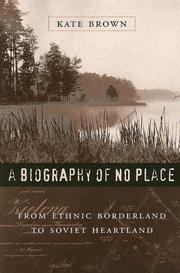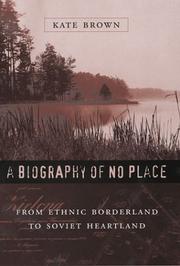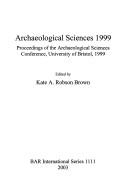| Listing 1 - 10 of 26 | << page >> |
Sort by
|

ISBN: 0674019490 9780674019492 0674011686 Year: 2004 Publisher: Cambridge, Mass. Harvard University Press
Abstract | Keywords | Export | Availability | Bookmark
 Loading...
Loading...Choose an application
- Reference Manager
- EndNote
- RefWorks (Direct export to RefWorks)
Cultural pluralism --- Former Polish Eastern Territories --- History. --- Ethnic relations. --- History of Eastern Europe --- anno 1900-1999 --- Poland --- Ukraine

ISBN: 0674028937 9780674028937 0674011686 9780674011687 0674019490 9780674019492 Year: 2022 Publisher: Cambridge, MA
Abstract | Keywords | Export | Availability | Bookmark
 Loading...
Loading...Choose an application
- Reference Manager
- EndNote
- RefWorks (Direct export to RefWorks)
This is a biography of a borderland between Russia and Poland, a region where, in 1925, people identified as Poles, Germans, Jews, Ukrainians, and Russians lived side by side. Over the next three decades, this mosaic of cultures was modernized and homogenized out of existence by the ruling might of the Soviet Union, then Nazi Germany, and finally, Polish and Ukrainian nationalism. By the 1950s, this “no place” emerged as a Ukrainian heartland, and the fertile mix of peoples that defined the region was destroyed. Kate Brown’s study is grounded in the life of the village and shtetl, in the personalities and small histories of everyday life in this area. In impressive detail, she documents how these regimes, bureaucratically and then violently, separated, named, and regimented this intricate community into distinct ethnic groups. Drawing on recently opened archives, ethnography, and oral interviews that were unavailable a decade ago, A Biography of No Place reveals Stalinist and Nazi history from the perspective of the remote borderlands, thus bringing the periphery to the center of history. We are given, in short, an intimate portrait of the ethnic purification that has marked all of Europe, as well as a glimpse at the margins of twentieth-century “progress.”
Cultural pluralism --- Cultural diversity --- Diversity, Cultural --- Diversity, Religious --- Ethnic diversity --- Pluralism (Social sciences) --- Pluralism, Cultural --- Religious diversity --- Culture --- Cultural fusion --- Ethnicity --- Multiculturalism --- Former Polish Eastern Territories --- Eastern Provinces (Former Polish territories) --- Eastern Territories (Former Polish territories) --- Former Eastern Territories of Poland --- Kresy Wschodnie (Former Polish territories) --- Ziemie Wschodnie (Former Polish territories) --- Ziemie Zabrany (Former Polish territories) --- History. --- Ethnic relations. --- Ziemie Zabrane (Former Polish territories) --- History of Eastern Europe --- anno 1900-1999 --- Poland --- Ukraine
Multi
ISBN: 9781447318187 9781447318170 9781447318194 Year: 2017 Publisher: Bristol Policy Press
Abstract | Keywords | Export | Availability | Bookmark
 Loading...
Loading...Choose an application
- Reference Manager
- EndNote
- RefWorks (Direct export to RefWorks)
Social problems --- Social policy and particular groups --- United Kingdom
Book
ISBN: 1447318226 144731820X 1447318196 144731817X Year: 2015 Publisher: Bristol : Policy Press,
Abstract | Keywords | Export | Availability | Bookmark
 Loading...
Loading...Choose an application
- Reference Manager
- EndNote
- RefWorks (Direct export to RefWorks)
This book draws on in-depth research with marginalised young people and the professionals who support them to explore the implications of a 'vulnerability zeitgeist', asking how far the rise of vulnerability in welfare and criminal justice processes serves the interests of those who are most disadvantaged.
Society. --- Young adults --- Conflict of generations. --- Social conditions. --- Psychology. --- Young people --- Young persons --- Adulthood --- Youth --- Gap, Generation --- Generation gap --- Generational conflict --- Intergenerational conflict --- Generations --- Intergenerational relations --- Social conflict

ISBN: 9781407300351 1407300350 Year: 2007 Publisher: Oxford : Archaeopress,
Abstract | Keywords | Export | Availability | Bookmark
 Loading...
Loading...Choose an application
- Reference Manager
- EndNote
- RefWorks (Direct export to RefWorks)
BABAO. --- Bones --- Bones --- Excavations (Archaeology) --- Human remains (Archaeology) --- Paleopathology --- Physical anthropology --- Analysis --- Diseases
Book
ISBN: 9780226242798 Year: 2015 Publisher: Chicago (Ill.) University of Chicago Press
Abstract | Keywords | Export | Availability | Bookmark
 Loading...
Loading...Choose an application
- Reference Manager
- EndNote
- RefWorks (Direct export to RefWorks)
Book
ISBN: 9780241352069 Year: 2019 Publisher: Great Britain Allen Lane, an imprint of Penguin Books
Abstract | Keywords | Export | Availability | Bookmark
 Loading...
Loading...Choose an application
- Reference Manager
- EndNote
- RefWorks (Direct export to RefWorks)
Hygiene. Public health. Protection --- anno 1980-1989 --- Chernobyl

ISBN: 1841714895 Year: 2003 Publisher: Oxford : Archaeopress,
Abstract | Keywords | Export | Availability | Bookmark
 Loading...
Loading...Choose an application
- Reference Manager
- EndNote
- RefWorks (Direct export to RefWorks)
Archaeology --- Archaeometry --- Methodology
Book
ISBN: 9782330189457 2330189451 Year: 2024 Publisher: Arles: Actes Sud,
Abstract | Keywords | Export | Availability | Bookmark
 Loading...
Loading...Choose an application
- Reference Manager
- EndNote
- RefWorks (Direct export to RefWorks)
C’est l’histoire d’une utopie, à deux extrémités du monde. L’histoire d’un rêve tragique au cœur de la guerre froide. L’histoire de deux ennemis hantés par la Bombe. L’histoire de deux villes fermées, reflets l’une de l’autre, unies par la peur de l’apocalypse, par leur haine réciproque et par une même obsession, la production effrénée de plutonium : Richland et son usine de Hanford, aux États-Unis ; Ozersk et son usine de Mayak, en URSS. Premiers sites de production de plutonium au monde, Hanford (1943) et Mayak (1946) ont été créés pour alimenter en ogives et en missiles les arsenaux nucléaires des deux blocs. Kate Brown révèle comme le complexe militaro-industriel des deux plus grandes puissances a manœuvré pour imposer un tel projet scientifique et technologique ; comment, pour préserver le secret, elles ont bâti une société ségréguée, hiérarchisée, surveillée, liberticide, mais offrant une garantie à ses employés : la sécurité matérielle et financière. Kate Brown a passé des années à explorer les archives longtemps inaccessibles de Hanford et de Mayak. Elle est parvenue à gagner la confiance de nombreux témoins directs et à détricoter le tissu de secrets et de mensonges qui recouvre la course aux armements à partir des années 1940. Elle montre comment ces usines ont joué un rôle quatre à cinq fois plus destructeurs que Tchernobyl en dévastant, dans le plus grand silence, d’immenses territoires et la santé des populations sur plusieurs générations. Richland et Ozersk semblaient tenir les promesses du rêve américain et du communisme soviétique. En réalité, elles ont dissimulé des désastres qui menacent toujours.
Plutonium industry --- Working class families --- Industrial safety --- Ozërsk (Chelia͡binskaia͡ oblastʹ, Russia) --- Richland (Wash.)
Book
ISBN: 019066097X 0190660988 0190660961 Year: 2018 Publisher: New York, NY : Oxford University Press,
Abstract | Keywords | Export | Availability | Bookmark
 Loading...
Loading...Choose an application
- Reference Manager
- EndNote
- RefWorks (Direct export to RefWorks)
Lake Baikal in Siberia is a global treasure, ecologically unique, and local environmentalists have been striving for decades to protect it. Spanning the Soviet/post-Soviet divide, their activism has engaged globalization, neoliberalism and resurgent authoritarianism under Putin. Ultimately, this work examines how this dynamic struggle provides a new understanding and theory of contemporary civil society.
Environmentalism --- Environmentalism --- Civil society --- Authoritarianism --- Political aspects --- Baikal, Lake (Russia) --- Baikal, Lake, Region (Russia) --- Environmental conditions. --- Environmental conditions.
| Listing 1 - 10 of 26 | << page >> |
Sort by
|

 Search
Search Feedback
Feedback About UniCat
About UniCat  Help
Help News
News